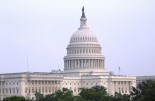AXA IM: EU green growth to deal with protectionist US administration

A proper EU growth strategy might deal better with a protectionist US administration than engaging in retaliatory action. 'Green growth' would be a natural place to start, says Giles Moëc, AXA Group Chief Economist and Head of AXA IM Research, as it could fit the EU’s values as well as prove beneficial to the continent’s economic fate.
|
Developing a proper growth strategy in the EU would not necessarily protect Europe fully from the US protectionist temptations, but it could be a more fruitful strategy, down the line, than merely engaging in retaliatory action, even if it is carefully targeted. 'The energy transition could be a key area for such EU growth strategy. This may sound surprising given the current gloom on climate change mitigation,' Moëc writes in his weekly Macrocast. 'But we think it is worth re-stating that decarbonising is in the economic interest of Europe when one considers the massive income transfers to the rest of the world from the net imports of fossil fuels – notably to the US – and the long-term cost to investment of the volatility which they entail. Further progress on electrification would reduce Europe’s fossil fuel bill. This would come with a daunting investment effort, but rather than seeing it purely as a cost, we should balance it against the tangible economic benefits.' Moëc names four reason for why green growth could be key for the EU region’s growth: |
|









